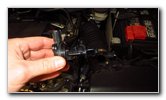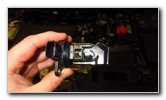Honda Civic MAF Sensor
Replacement Guide
How to clean or change the mass air flow
sensor in a 10th generation 2016, 2017, 2018 and 2019 Honda Civic.
By Paul B. Michaels Author & Photographer Auto Mechanic Since 1989 |
||
 2016 Civic 2.0L I4 Engine |
 Engine Air Box & Intake |
|
| This automotive
maintenance tutorial was specifically written to assist owners of the tenth
generation 2016, 2017, 2018 and 2019 Honda Civic in removing and cleaning or
changing the MAF (mass air flow) sensor for the Earth Dreams 2.0L I4 engine. Owners of other Honda or Acura vehicles such as the Accord, Insight, Clarity, Fit, HR-V, CR-V, Pilot, Passport, Odyssey, Ridgeline, ILX, MDX, RDX, NSX, RLX and TLX may also find these DIY instructions to be helpful. The procedure should be the same or very similar for Civic models equipped with the turbocharged 1.5L I4 engine. A few symptoms of a dirty, failing or faulty MAF sensor include the following: poor fuel economy (low MPG), rough idling, hesitation, jerking, stalling, loss of power, a gasoline odor from the exhaust pipe, difficulty starting and a warning light on the gauge cluster (CEL / SES - check engine light / service engine soon). If you have an OBDII Scanner (also known as an OBD2 scan tool or code reader), check to see if any of the DTCs (diagnostic trouble codes) are related to the MAF sensor such as P0100, P0101, P0102, P0103 and P0104. The OEM mass air flow sensor part number is Honda 37980-5BA-A01. A few other compatible replacement aftermarket MAF sensors with their part numbers include the following: Jesben 37980-5BA-A01, Aotop 6441567721757, Loovey 37980-5BA-A01 and Germban 37980-5BA-A01. The only tool needed to remove and replace the sensor is a standard Phillips head screwdriver. The first two steps are to open the hood and then move to the right (driver) side of the engine bay. |
||
|
|
||
 MAF Sensor - Intake Hose |
 Push In Release Tab |
|
| Locate the engine
air filter box situated to the left fuse box, in front of the 12V automotive
battery and behind the driver side headlight assembly. The black plastic MAF sensor is attached to the top of the engine air filter box close to the rubber air intake hose. Push in the release tab on the electrical connector before sliding it straight off the right side of the sensor. |
||
 Pull Off Electrical Connector |
 Loosen Counterclockwise |
|
| Loosen the two screws on the top of the old sensor in the counterclockwise direction with the Phillips head screwdriver. | ||
 Remove Two Screws |
 2 Screws Removed |
|
| Once the two screws
are loose, spin them out the rest of the way with your fingers to help
prevent them from falling down into the engine bay and becoming lost. Set the two small Phillips head screws aside in a safe place. |
||
 Rotate To Loosen Sensor |
 Pull Out Old Sensor |
|
| Gently rotate the
old sensor back and forth a few times to make sure it isn't stuck in the air
intake tube. Carefully pull the old sensor straight out of the air box. |
||
 Inspect Old Sensor |
 Sensor "Hot-Wire" |
|
| Inspect the old
sensor and check to see if the "hot-wire" is covered in oil, soot or other
debris. If you would like to try cleaning the old sensor before purchasing a new one, use some Mass Air Flow Cleaner Spray. Carefully spray the sensor wire with the cleaning spray and allow it to air dry. Avoid touching the wire with your fingers or applying too much pressure with the spray. Do not spray the MAF cleaner into the electrical contacts. |
||
|
|
||
 OEM Part Number |
 Line Up New Sensor |
|
| Once the old sensor
is dry, line it up with the port (opening) in the top of the air box. If you are installing a new sensor, the OEM (original equipment manufacturer) part number is Honda 37980-5BA-A01. Be sure to inspect the wiring harness and electrical connector for any physical damage from rodents chewing on them or rust from the components getting wet. |
||
 Install New Sensor |
 Spin In Two Screws |
|
| Carefully push the
new sensor into the air box.
Avoid rubbing or bending the sensor wire on the edges of the opening in the air box. Rotate the new sensor until the screw holes line up together. Spin in the two screws a few turns by hand to help prevent from having them fall down into the engine bay and become lost. |
||
 Tighten Clockwise |
 Tighten Second Screw |
|
| Tighten the two
screws in the clockwise direction with the Phillips head screwdriver until
they are snug. Try to avoid over tightening the screws to prevent from cracking the plastic sensor housing. |
||
 Push On Power Plug |
 MAF Sensor Replaced |
|
| Push the electrical
connector straight on to the base of the new sensor. You should hear or feel the power plug "click" securely into place. Turn the ignition switch to the "On" position but do not start the engine. (Or press the "Start" button once with your foot off the brake pedal for vehicles equipped with the push button start system.) Use your OBDII Scanner to clear any MAF related codes. Then turn the ignition switch to the "Off" position and back again to "On". Check to see if the SES / CEL warning light is no longer displayed on the gauge cluster. Take the car for a short test drive to see if the engine is behaving normally. Be sure to record the MAF sensor cleaning or replacement in your vehicle's service records. Please
check out all of my
2016-2019 Honda Civic DIY Repair & Maintenance Guides. |
||
| If you found this guide to be helpful,
please consider making a small donation by clicking on the PayPal.com
"Donate" button located to the right of this paragraph. Thank you!
(Note: I am not a registered charity. Donations are not tax deductible.) |

